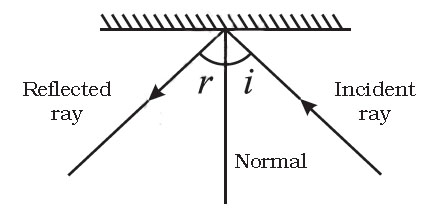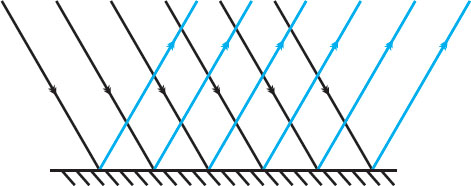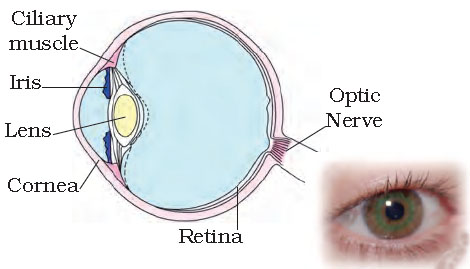The sense of sight is one of the most important senses. Through it we see mountains, rivers, trees, plants, chairs, people and so many other things around us.
The eyes alone cannot see any object. It is only when light from an object enters our eyes that we see the object. The light may have been emitted by the object, or may have been reflected by it.
The light ray, which strikes any surface, is called the incident ray. The ray that comes back from the surface after reflection is known as the reflected ray.
When the light passing on straight line and make angle of 90° to the line representing the mirror at the point where the incident ray strikes the mirror. This line is known as the normal to the reflecting surface at that point.
The angle between the normal and incident ray is called the angle of incidence (∠i). The angle between the normal and the reflected ray is known as the angle of reflection (∠r) .

The angle of incidence is always equal to the angle of reflection.
The incident ray, the normal at the point of incidence and the reflected ray all lie in the same plane. This is another law of reflection.
When all the parallel rays reflected from a rough or irregular surface are not parallel, the reflection is known as diffused or irregular reflection. The diffused reflection is not due to the failure of the laws of reflection. It is caused by the irregularities in the reflecting surface. On the other hand, reflection from a smooth surface like that of a mirror is called regular reflection. Images are formed by regular reflection.

When all the parallel rays reflected from a rough or irregular surface are not parallel, the reflection is known as diffused or irregular reflection.
It's possible that reflected light can reflected again. We can at saloon, after your hair cut is complete, she/he holds a mirror behind you to show he/she how the hair has been cut
A number of images formed by mirrors placed at an angle to one another is used in a kaleidoscope to make numerous beautiful patterns.
An interesting feature of a kaleidoscope is that you will never see the same pattern again. Designers of wallpapers and fabrics and artists often use kaleidoscopes to get ideas for new patterns.
The sunlight is referred to as white light. But it consists seven colors.
The eye has a roughly spherical shape. The outer coat of the eye is white. It is tough so that it can protect the interior of the eye from accidents. Its transparent front part is called cornea.
Behind the cornea, we find a dark muscular structure called iris. In the iris, there is a small opening called the pupil. The size of the pupil is controlled by the iris. The iris is that part of eye which gives it its distinctive colour.

The lens focuses light on the back of the eye, on a layer called retina. The retina contains several nerve cells. Sensations felt by the nerve cells are then transmitted to the brain through the optic nerve. There are two kinds of cells−
Cones sense colour. At the junction of the optic nerve and the retina, there are no sensory cells, so no vision is possible at that spot. This is called the blind spot.
The impression of an image does not vanish immediately from the retina. It persists there for about 1/16th of a second. So, if still images of a moving object are flashed on the eye at a rate faster than 16 per second, then the eye perceives this object as moving.
Sometimes, particularly in old age, eyesight becomes foggy. It is due to the eye lens becoming cloudy. When it happens, persons are said to have cataract. There is a loss of vision, sometimes extremely severe. It is possible to treat this defect. The opaque lens is removed and a new artificial lens is inserted.
It is necessary that you take proper care of our eyes. If there is any problem we should go to an eye specialist.
Lack of vitamin A in foodstuff is responsible for many eye troubles. Most common amongst them is night blindness.
Eggs, Raw carrots, broccoli and green, vegetable, milk, curd, cheese, butter and fruits such as papaya and mango are also rich in vitamin A.
Some persons, including children, can be visually impaired. They have very limited vision to see things. Some persons cannot see at all since birth. Some persons may lose their eyesight because of a disease or an injury. Such persons try to identify things by touching and listening to voices more carefully. They develop their other senses more sharply. However, additional resources can enable them to develop their capabilities further.
The most popular resource for visually challenged persons is Braille. The present system was adopted in 1932. There is Braille code for common languages, mathematics and scientific notation. Many Indian languages.
